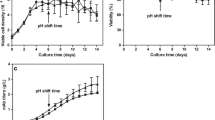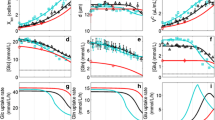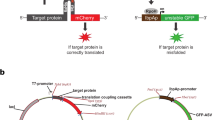Abstract
Because of the interest in understanding and optimizing secretion of proteins from mammalian cells, reliable and more reproducible methods are needed to monitor the external redox potential of animal cells in suspension culture. An improved off-line method was established that greatly reduces the typically long response time of redox electrodes in cell culture media and improves the standardization of redox probes. In addition, the dependence of medium redox potential on dissolved oxygen concentrations and pH was investigated using cell-free medium. Off-line as well as on-line redox potential measurements were then applied to spinner or bioreactor cultures of murine hybridoma cells. Serum containing or protein-free medium were used. The time dependence of the experimentally determined external redox potential was found to be affected not only by oxygen, pH, and medium composition. but to a significant extent by the rate of generation of reductants by hybridoma cells. The observed specific rate of medium reduction by generation of reductants (ΔmV h−1 viable cell−1) decreased during exponential growth while cell number increased from 2×105 viable cells ml−1 to 3.5×106 viable cells ml−1. This rate, however, was essentially constant at −7.3 mV h−1±3.7 mV h−1 per 1010 viable cells during growth under conditions of constant dissolved oxygen tension and constant pH. Using these observations, the quantity of reductants synthesized and secreted into the medium by viable hybridoma cells was estimated to be approximately 1.3 mole h−1 per 1010 viable hybridoma cells. The time course of specific monoclonal antibody secretion rate did not correlate with changes in the external oxidation/reduction potential in either serum containing or protein-free medium.
Similar content being viewed by others
References
Abrams PG, Knost JA, Clark G, Wilburn S, Oldham RK and Foon KA (1983) Determination of optimal human cell lines for development of human hybridomas. J. Immunol. 131: 1201–1207.
Balakireva LM and Kantere VM (1974) The redox potential in microbiological media. Biotechnol. Bioeng. Symp. 4: 769–780.
Bates RG (1973) Determination of pH, theory and practice. New York, Wiley.
Broome JD and Jeng MW (1073) Promotion of replication in lymphoid cells by specific thiols and disulfidesin vitro. J. Exp. Med. 138: 574–592.
Chen C and Hirsch JG (1972) Restoration of antibody forming capacity in cultures of nonadherent spleen cells by mercaptoethanol. Science 176: 60–61.
Chen C and Hirsch JG (1972) The effects of mercaptoethanol and of peritoneal macrophages on the antibody-forming capacity of nonadherent spleen cellsin vitro. J. Exp. Med. 136: 604–617.
Click RE, Benk L and Alter BJ 61972) Enhancement of antibody synthesisin vitro by mercaptoethanol. Cell Immunol. 3: 155–160.
Click RE, Benk L and Alter BJ (1972) Immune responsesin vitro. I. Culture conditions for antibody synthesis. Cell Immunol. 3: 264–276.
Daniels WF, Parker DA, Johnson RW and Schneider LE (1970) Controlled pH and oxidation-reduction potential with a new glass tissue fermentor. Biotechnol. Bioeng. 7: 529–553.
Daniels WF, Garcia LH and Rosensteel JF (1970) The relationship of oxidation-reduction potential to the growth performance of tissue culture media poised prior to incubation. Biotechnol. Bioeng, 7: 409–417.
Daniels WF, Garcia LH and Rosensteel JF (1970) Oxidation-reduction potential and concomitant patterns of cultures of Earle's L cell in centrifuge bottle spinners. Biotechnol. Bioeng. 7: 419–428.
Flickinger MC, Goebel NK and Bohn MA (1990) Determination of specific monoclonal antibody secretion rate during very slow hybridoma growth. Bioprocess Eng. 5: 155–164.
Glacken MW (1988) Catabolic control of mammalian cell culture. Bio/Technology 6: 1041–1050.
Glacken NW (1991) Bioreactor control and optimization. In: Ho CS and Wang DIC (eds) Animal cell bioreactors. (pp. 373–403) Butterworth-Heinemann, Boston.
Griffiths B (1948) The use of oxidation-reduction potential (ORP) to monitor growth during a cell culture. Dev. Biol. Stand. 55: 113–116.
Hwang C and Sinskey J (1991) The role of oxidation-reduction potential in monitoring growth of cultured mammalian cells. In: Spier RE, Griffiths JB and Meignier JB (eds). Production of biological animal cells in culture. (pp. 548–568) Butterworth-Heinemann, Oxford.
Hwang C, Sinskey AJ and Lodish HF (1992) Oxidized redox state of glutathione in the endoplasmic reticulum. Science 257: 1496–1502.
Ishii T, Bannai S and Sugita Y (1981) Mechanism of growth stimulation of L1210 cells by 2-mercaptoethanolin vitro. J. Biol. Chem. 256: 12387–12392.
Johnson BJ, Borowski J and Engblom C (1964) Steam sterilizable probes for dissolved oxygen measurement. Biotech. Bioeng. 60: 457–468.
Kearney JF, Radbruch A, Liesegang B and Rajewsky K (1979) A new mouse myeloma cell line that has lost immunoglobulin expression but permits the construction of antibody-secreting hybrid cell lines. J. Immunol. 123: 1548–1550.
Kjaergaard L (1977) The redox potential: Its use and control in biotechnology. Adv. Biochem. Eng. 7: 131–150.
Kwong SCW and Rao (1991) Utility of culture redox potential for identifying metabolic state changes in amino acid fermentation. Biotechnol. Bioeng. 38: 1034–1040.
Kwong SCW and Rao (1992) Effect of reducing agents in an aerobic amino acid fermentation. Biotechnol. Bioeng. 40: 851–857.
Kwong SCW and Rao (1992) On-line assessment of metabolic activities based on culutre redox potential and dissolved oxygen profiles during aerobic fermentation. Biotechnol. 8: 576–579.
Mertem OW (1988) Sensors for the control of mamalian cell processes. In: Spier RE and Griffiths JB (eds.) Animal cell biotechnology. Vol. 3 (pp 75–139) Academic Press, London, Orlando.
Morgan Jr. AC, Galloway DR and Reisfeld RA (1981) Production and characterization of monoclonal antibody to a melanoma specific glycoprotein. Hybridoma 1: 27–36.
Noelle RJ and Lawrence DA (1981) Modulation of T-cell function: II. Chemical basis for the involvement of cell surface thiol-reactive sites in control of T-cell proliferation. Cell Immunol. 60: 453–469.
Noelle RJ and Lawrence DA (1981) Determination of glutathione in lymphocytes and possible association of redox state and proliferative capacity of lymphocytes. Biochem. J. 198: 571–579.
Ohmori H and Yamamoto I (1983). Activation of murine lymphocytes by 2-mercaptoethanol and related thiol compounds and its mechanism. I Relationship between mitrogenic activities and augmenting of antibody synthesisin vitro. Immunopharmacol. 3: 333–345.
Ohmori H and Yamamoto I (1983). Mechanism of augmentation of the antibody response by 2-mercaptoethanol in murine lymphocytes. I. 2-mercaptoethanol-induced stimulation of the uptake ofcystine, an essential amino acid. J. Exp. Med. 155: 1277–1290.
Ohmori H and Yamamoto I (1983). Mechanism of augmentation of the antibody response by 2-mercaptoethanol in murine lymphocytes. II. A major role of the mixed disulfide between 2-mercaptoethanol and cystein. Cell. Immunol. 79: 173–185.
Ohmori H and Yamamoto I (1983) Mechanism of augmentation of the antibody response by 2-mercaptoethanol in murine lymphocytes. III. Serum bound and oxidized 2-mercaptoethanol in murine lymphocytes are available for the augmentation. Cell. Immunol. 79: 186–196.
Optitz HG, Optiz U, Lemke H, Hewlett G, Schreml W and Flad HD (1977) The role of fetal calf serum the primary immune responsein vitro. J. Exp. Med. 145: 1029–1038.
Rippon JW (1968) Monitored environment system to control cell growth, morphology and metabolic rate in fungi by oxidation-reduction potentials. Appl. Microbiol. 16: 114–121.
Roth M (1971) Fluorescense reaction for amino acids. Analyt. Chem. 43: 880–882.
Scheirer W and Merten O-W (1991) Instrumentation of animal cell culture reactors. In: Ho CS and Wang DIC (eds) Animal cell bioreactors. (pp. 405–443) Butterworth-Heinemann, Boston.
Shibai H, Ishizaki A, Koboyashi K and Hirose Y (1971) Simultaneous mesurement of dissolved oxuygen and oxidation-reduction potential in aerobic culture. Agr. Biol. Chem. 38: 3207–2411.
Wiles CC and Smith VC (1969) Oxidation-reduction potential controlled submerged tissue culture fermentation in pilot-scale fermenters. In: Am. Inst. Chem. Eng. Symp. Bioeng. Technol., Nov. 1969, (pp. 85–93).
Wimpenny JWT (1969) The effect of Eh on regulatory processes in facultative anaerobes. Biotechnol. Bioeng. 11: 623–629.
Yang X, Oehlert GW and Flickinger MC (1996) Use of the weighted Jackknife method to calculate the variance in cellular specific protein secretion rate: Application to monoclonal antibody secretion rate kinetics in response to osmotic stress. Biotechnol. Bioeng. (in press).
Author information
Authors and Affiliations
Rights and permissions
About this article
Cite this article
Pluschkell, S.B., Flickinger, M.C. Improved methods for investigating the external redox potential in hybridoma cell culture. Cytotechnology 19, 11–26 (1995). https://doi.org/10.1007/BF00749751
Received:
Accepted:
Issue Date:
DOI: https://doi.org/10.1007/BF00749751




